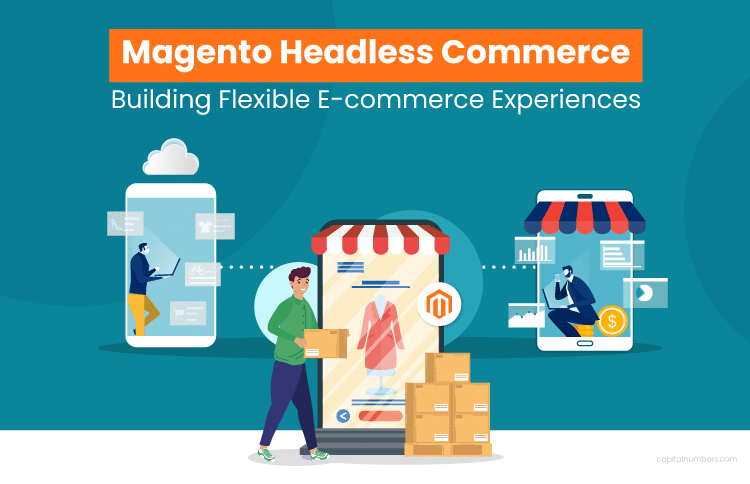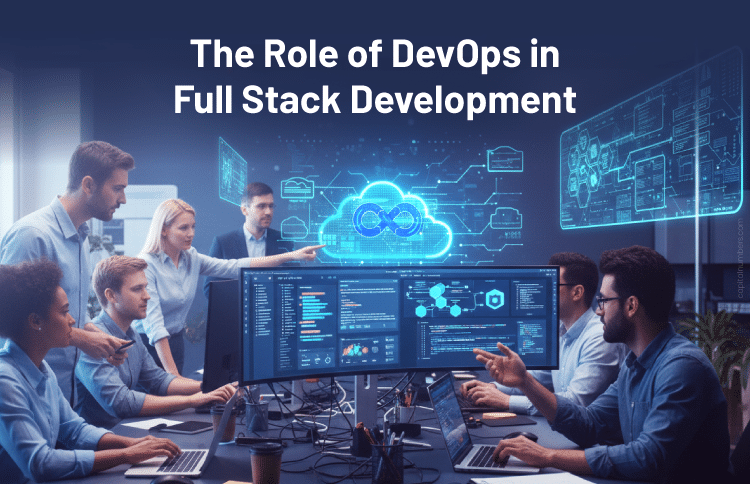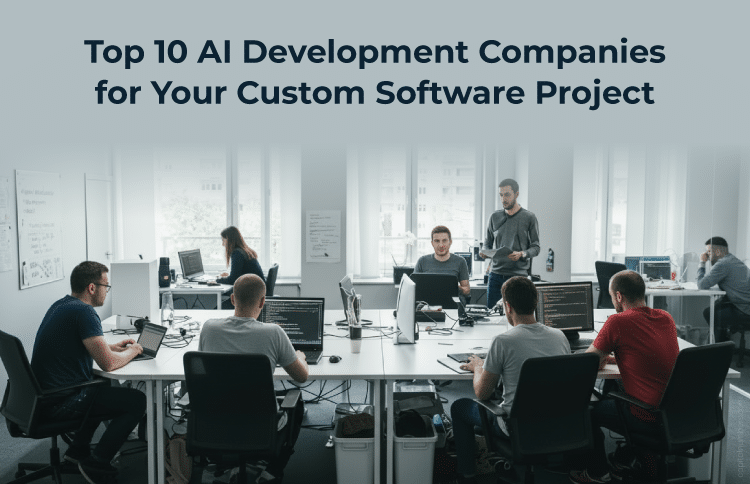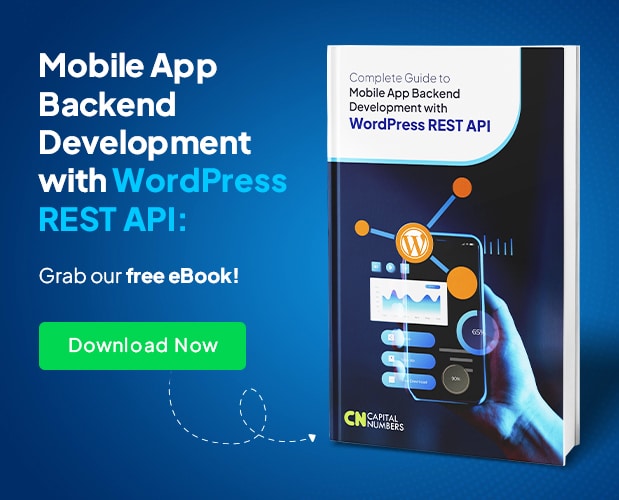Magento Headless Commerce: Building Flexible E-commerce Experiences
Table of Contents
In the rapidly evolving world of e-commerce, the traditional, monolithic approach is giving way to a more dynamic and flexible architecture. For businesses powered by Magento, this evolution is taking the form of headless commerce. This approach separates the customer-facing storefront from the backend commerce engine, enabling unprecedented control over user experience, performance, and omnichannel strategy.
What is Headless Commerce?
Traditionally, eCommerce platforms have been monolithic, meaning the frontend (the website your customers see and interact with) and the backend (the system that manages products, orders, and payments) are tightly coupled. This can make it difficult and time-consuming to make changes to the user experience without affecting the underlying backend.
Headless commerce decouples the frontend from the backend. The “head” (the frontend) is removed, leaving the “body” (the backend) to handle all the core commerce functionalities. The frontend can then be built using any technology, such as a modern JavaScript framework like React or Vue.js, and communicates with the backend via an API (Application Programming Interface).
What is Magento Headless Commerce?
Magento Headless Commerce applies this decoupled architecture to the powerful Magento platform. Instead of using Magento’s default frontend, you can build a completely custom storefront or use a variety of other “heads” to deliver your products and services. This could be a progressive web app (PWA), a mobile app, a point-of-sale (POS) system, or even an IoT device.
This approach allows you to leverage Magento’s robust backend for things like:
- Catalog management
- Product information management
- Order and inventory control
- Payment and shipping
- Promotions and pricing rules
- Customer accounts
while having complete freedom on the frontend to create the best possible user experience.
The Headless Commerce Flowchart
The following flowchart provides a detailed look at how data and requests flow through a headless Magento architecture. It illustrates the separation of concerns and the role of the API as the critical bridge between the front-end and back-end.
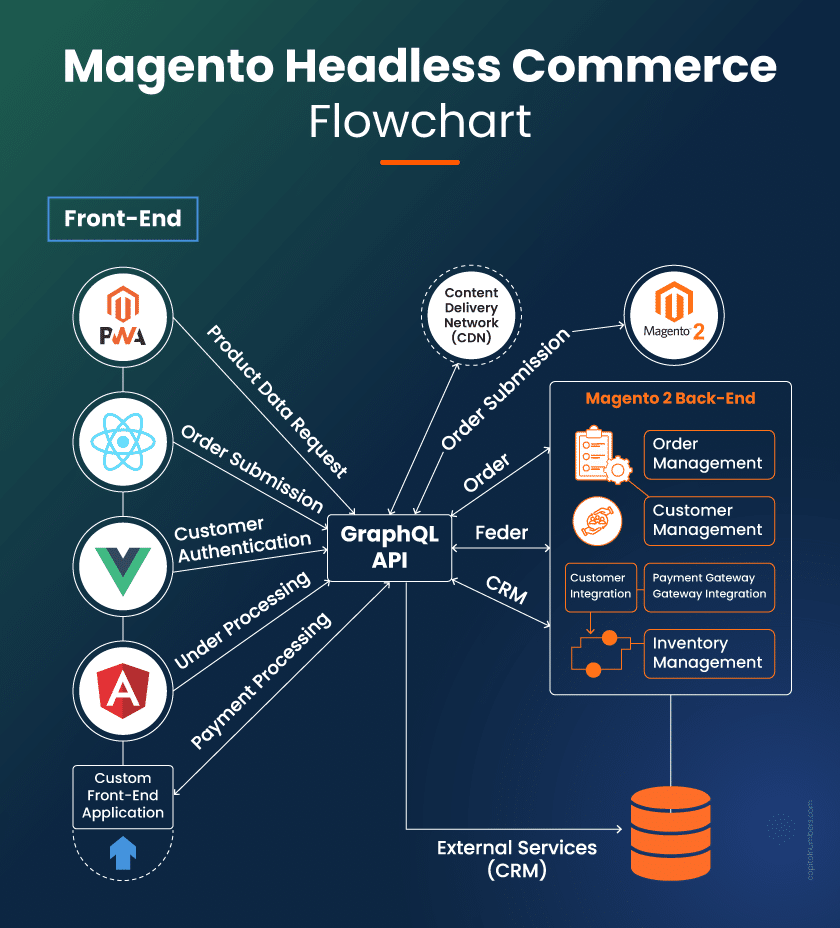
In this model, the Front-End Applications (like PWAs or custom apps) send requests to the GraphQL API. This API then communicates with the Magento 2 Back-End to fetch product data, process orders, manage customers, and integrate with other services. This architecture ensures a highly scalable and adaptable system that can meet the demands of modern eCommerce.
The Benefits of Going Headless with Magento
Adopting a headless approach with Magento provides a wide array of advantages that can significantly impact your business’s growth and efficiency.
1. Unmatched Flexibility and Customization
With a headless setup, you are no longer limited by Magento’s default templating engine (PHTML). This frees your design and development teams to create completely custom and unique user experiences that perfectly align with your brand’s vision. You can build bespoke storefronts, integrate advanced features, and test new ideas without the constraints of a monolithic system.
2. Enhanced Performance and Speed
By decoupling the frontend, you can build a lightweight, fast-loading storefront. Modern frontend frameworks and technologies like Progressive Web Apps (PWAs) and server-side rendering can be leveraged to deliver superior performance. This directly improves SEO rankings, reduces bounce rates, and boosts conversion rates. The frontend can be served from a Content Delivery Network (CDN), further speeding up content delivery to customers worldwide.
3. True Omnichannel Experiences
A single Magento headless backend can power multiple “heads” or touchpoints. This means you can use the same backend to manage your website, a native mobile app, a smart device app, and even an in-store kiosk. This allows you to deliver a consistent, unified brand experience across all channels, providing a seamless shopping journey for your customers regardless of how they interact with your brand.
4. Increased Agility and Developer Productivity
The decoupled nature of headless commerce allows frontend and backend development teams to work in parallel. This enables faster development cycles and quicker time-to-market for new features and updates. Frontend developers can make changes and deploy updates without needing to touch the backend, and vice versa, leading to greater efficiency and collaboration.
The Architecture of Magento Headless Commerce
The key to Magento Headless Commerce is the API layer that sits between the frontend and the backend. This API, typically using GraphQL or REST, allows the two systems to communicate with each other.
Here’s a simplified view of the architecture:
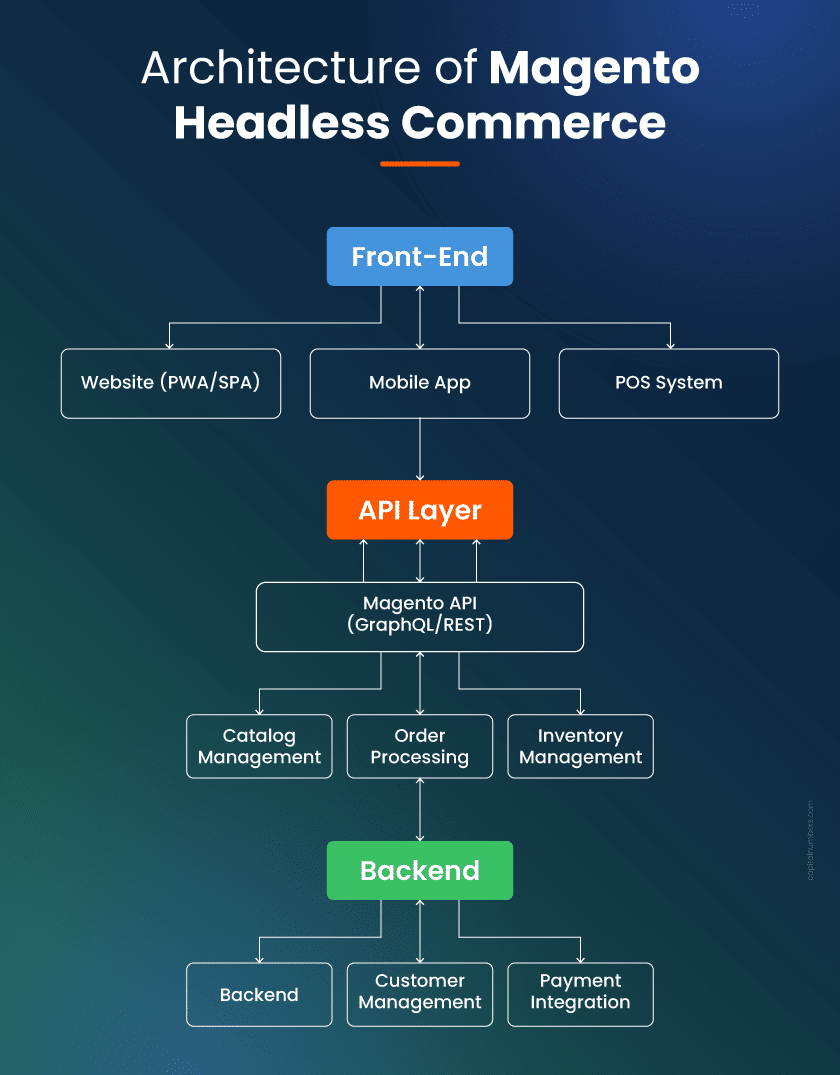
1. Frontend (The “Head”): This is what the customer interacts with. It can be a:
- Website: Built with a modern JavaScript framework like React, Vue.js, or Angular.
- Mobile App: A native iOS or Android app.
- POS System: In-store point-of-sale systems.
- Other Touchpoints: IoT devices, smart mirrors, voice assistants, etc.
2. API Layer: This is the communication bridge between the frontend and the backend. The frontend sends requests to the API for product data, customer information, and to perform actions like adding items to the cart or placing an order.
3. Backend (The “Body”): This is the Magento core, which handles all the commerce logic and data, including:
- Catalog Management
- Order Processing
- Inventory Management
- Customer Management
- Payment Gateway Integration
How to Implement Magento Headless Commerce: A Step-by-Step Guide
Transitioning to a headless architecture with Magento is a significant project that requires careful planning and execution.
1. Plan and Strategize
Before writing any code, define your goals.
- Audit your current setup: What Magento version are you on? (Magento 2.3+ is recommended for its robust GraphQL API). What extensions do you rely on?
- Define your “why”: Are you seeking better performance, a custom design, or an omnichannel strategy?
- Choose your frontend technology: Options like Magento PWA Studio (a Magento-native, React-based solution) or third-party frameworks like Vue Storefront offer different levels of flexibility and community support.
2. Configure the Magento Backend
Your existing Magento instance will become the commerce engine. Ensure it’s optimized for API calls.
- Enable and Configure APIs: Use Magento’s native GraphQL API, which is ideal for a headless setup because it allows the frontend to request only the data it needs in a single query.
- Audit and Adapt Extensions: Many traditional Magento extensions may not be compatible with a headless architecture. You may need to find API-first alternatives or build custom integrations to replicate their functionality.
3. Develop the Frontend
This is where the magic happens. Your chosen frontend framework will be used to build a new, standalone storefront.
- Start with Core Components: Build reusable UI components like product cards, a shopping cart, and a checkout page.
- Handle Routing and SEO: Implement server-side rendering (SSR) or static site generation (SSG) to ensure your new storefront is SEO-friendly and search engines can properly index your pages.
- Connect to Magento: Use libraries like Apollo Client to manage data fetching and communication with the Magento GraphQL API.
4. Deploy and Optimize
Once your new storefront is built, it needs to be deployed to its own hosting environment, separate from the Magento backend.
- Separate Hosting: Host your frontend on a platform like Vercel or Netlify, which are optimized for modern web applications. The Magento backend will be hosted on a separate server, communicating with the frontend only via APIs.
- Continuous Integration/Continuous Deployment (CI/CD): Set up automated pipelines to streamline updates and deployments for both the frontend and backend, ensuring a smooth and efficient workflow.
Challenges and Considerations
While the benefits are compelling, it’s crucial to be aware of the potential challenges:
- Increased Complexity and Cost: Headless projects are more complex than traditional ones. They require a higher upfront investment and a team with specialized skills in both modern frontend frameworks and Magento APIs.
- Extension Compatibility: As mentioned, many legacy Magento extensions are not built for a headless world. This can lead to extra development work to recreate functionality or find suitable replacements.
- Maintenance: You are now maintaining two distinct applications (the frontend and the backend). This requires a well-defined development and deployment strategy to ensure both are kept up-to-date and secure.
Is Magento Headless Right for Your Business?
Magento Headless Commerce is a powerful solution for businesses that want to create unique, high-performing, and scalable eCommerce experiences. It’s an excellent choice for:
- Businesses with a strong focus on user experience: If you want to create a highly customized and engaging storefront, headless is the way to go.
- Omnichannel retailers: If you sell across multiple channels, headless can help you provide a consistent and seamless experience.
- Businesses with high growth potential: The scalability of headless architecture makes it a great choice for businesses that are expecting rapid growth.
If you’re looking to take your eCommerce store to the next level, Magento Headless Commerce is definitely an option worth exploring.
Ready to Future-Proof Your E-commerce Store?
At Capital Numbers, we specialize in creating scalable, headless Magento solutions that provide speed, flexibility, and seamless user experiences. Whether you’re launching a new store or upgrading an existing one, our team is ready to help you innovate with confidence.
Hire our Magento developers to build a fast, flexible, and scalable e-commerce solution tailored to your business. Contact us today.

